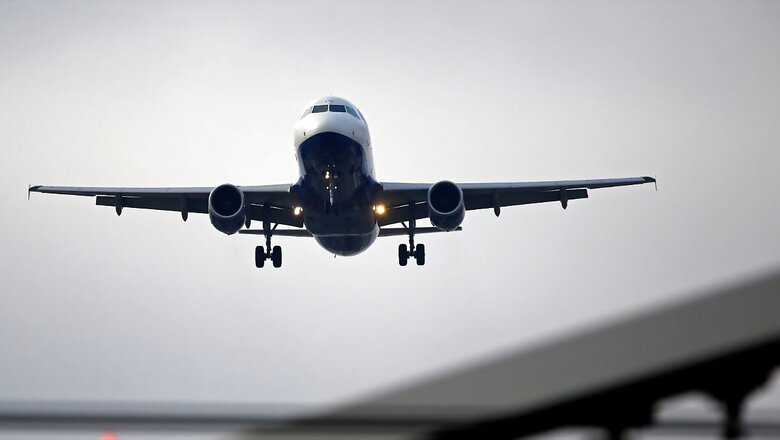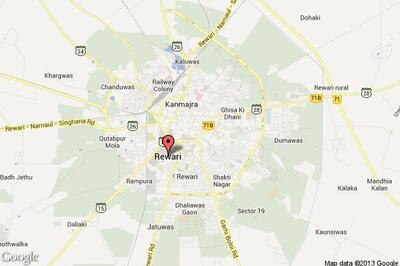
views
While a lot of political brouhaha is happening at the moment over the hike in airfare pan-India, I, as an aviation analyst, would bring to the fore some unknown points that cause the hike in airfare, which are purely based on factual technicalities and are unknown primarily to common people. Since my analysis would prioritise facts before fiction, any political bias would be totally irrelevant here. I would take into consideration the perspectives of both the airliners and the passengers sequentially. As far as commercial airliners are concerned, we need to look at its major cost components at the onset.
Here is a synopsis of the operating cost of an airliner, extracted from the books of The Federal Aviation Administration (FAA). The well-known and globally accepted FAA is a part of the US federal government that is responsible for controlling the use of aircraft.
AIRCRAFT OPERATING COSTS
Introduction
Aircraft variable operating costs are important factors in the evaluation of FAA investment and regulatory programs that concern the time spent in air transportation. The variable operating costs of aircraft affect aircraft operators directly and users of air service indirectly in the form of higher or lower fares or taxes.
Fixed aircraft costs may also be important in evaluating the effects of FAA investment and regulatory programs that affect fleet size, cause aircraft to be more productive, or cause aircraft to be out of service for extended periods.
To put airline costs in perspective, this section first shows the relationship of aircraft operating costs to total airline operating costs and then presents another disaggregation of total airline costs. After this, aircraft operating costs are presented in more detail. Costs in this section are shown for air carriers, general aviation and military equipment types.
Cost data is defined for air carrier and general aviation aircraft as variable or fixed. Variable costs change in proportion to aircraft usage, and include fuel and oil, maintenance and crew costs. Fixed costs show little or no change in proportion to changes in activity. For example, in the short term, a change in activity may not affect an operator’s decision about a specific aircraft or fleet of aircraft. In the longer term, the operator could change its fleet and ownership costs.
There are two estimates of fixed costs provided. The first is fixed accounting charges including depreciation, insurance, and rental charges reported by carriers in Form 41, or which have been estimated for GA aircraft. The second is provided for commercial aircraft only.
If an FAA initiative improves system efficiency, an operator may be able to provide the same service with fewer aircraft; alternatively, an FAA initiative may cause aircraft to be out of service or to be removed from the fleet entirely. In either case, an estimate of the benefit or cost to the carrier of an FAA initiative would include the carrier’s opportunity costs—the value of the aircraft in its next best use. One immediate alternative use of an aircraft might be to lease it out to another operator. Since there is a well-defined market for operating (short-term) leases for most aircraft types, one can use the average monthly lease rate as a good proxy for the benefit or cost over a defined period of time.
GENERAL AVIATION OPERATING COSTS
Data Sources for Operating Costs
The source for the variable and fixed operating costs for general aviation aircraft was The Aircraft Cost Evaluator, published by Conklin & de Decker.8 Costs assume an operator of one or two aircraft of a given model and do not reflect lower prices which may be available through bulk purchases.
The following variable cost categories were obtained from The Aircraft Cost Evaluator for use in this study:
Fuel & Oil
- Fuel (assuming fuel price of $5.13 per gallon for avgas and $4.73 for turbine fuel (Jet A)—costs based on a Conklin & de Decker survey of FBOs (Fixed Base Operators) at major general aviation airports in the United States
- Fuel Additives
- Lubricants
- Maintenance
- Maintenance Labour
- Parts Airframe/Engine/Avionics
Engine Restoration
- Thrust Reverser Overhaul
- Propeller Overhaul
- APU Overhaul
- Dynamic Components/Life Limited Parts
Crew Salaries (based on NBAA Salary Survey and other sources)
- Captain
- Co-pilot
- Flight Engineer/Other
- Benefits
Maintenance labour costs represent the average cost of routine, scheduled, and unscheduled maintenance labour. Labour hours are based on data from operator experience, manufacturer’s data and surveys. Crew salaries are derived for each aircraft type from a recognized pilot salary survey, and benefits are typically an additional 30 percent of wages. Salaries are counted for the entire crew, which depending on the aircraft type can consist of a captain, copilot and flight engineer. Crew salaries and benefits are divided by Conklin & de Decker’s estimated annual flight hours for that model in order to obtain hourly crew costs.
The Aircraft Cost Evaluator also provided the following fixed costs:
- Hangar Rental
- Insurance
- Hull
- Single Limit Liability
- Miscellaneous Overhead
- Recurrent Training
- Aircraft Modernization
- Navigation Chart Services
- Refurbishing
- Computerized Maintenance
Management Program
- Weather Service
- Other Fixed Cost
- Fractional Cost/Year + Tax
The Aircraft Cost Evaluator provides different cost categories based on the type of operation for which an aircraft is used. It was assumed that piston and turboprops (categories 1-4) are used in business operations; turbojets (category 5) are used in corporate operations; piston engine rotorcraft (category 6) are used in utility operations; and turbine rotorcraft engine (categories 7 and 8) are used in commercial operations.
Business operating costs from Conklin & de Decker assume that the aircraft is owner-flown and therefore no crew salaries are included as costs. However, for economic analysis, the costs of a pilot’s time should be considered.
Depreciation
In order to reflect general aviation aircraft ownership costs, estimates based on replacement costs were developed for this report. Depreciation is a significant component of the fixed costs for general aviation aircraft. In this report, we use Conklin & de Decker’s market-based depreciation values, which assume that aircraft lose a fixed percentage of their original purchase price each year, with no residual value.
The percentage used varies by aircraft type, as follows:
- Jets: 4 percent
- Rotorcraft: 5 percent
- Turboprops and Pistons: 6 percent
Calculation of costs by operating rule part
- For each aircraft, multiply variable and total costs by the number of hours it operated under uses corresponding to each of the operating rule parts.
- Sum these products by Aircraft Category, producing a single value for each cost element, for each operating rule part.
- Divide these sums by the total hours flown by aircraft in that Aircraft Category under that operating rule part.
In addition to the above-mentioned costs, let us now look at the credibility factors of any Airliner which draw the direct interest of investors.
Revenue Per Available Seat Mile (RASM)
Revenue per available seat mile (RASM) is a unit of measurement commonly used to compare the efficiency of various airlines. It is obtained by dividing operating income by available seat miles (ASM). Generally, the higher the RASM, the more profitable the airline under question. Revenue is not solely limited to ticket sales, as other factors of efficiency and profitability are taken into account.
KEY TAKEAWAYS
- Airlines use revenue per available seat mile to measure the total operating revenue they generate per seat (empty or full) per mile flown.
- Airlines favour using RASM as a metric to show their financial performance because it includes additional sources of revenue, such as baggage fees, reservation change fees, and inflight meals.
- The calculation for revenue per available seat mile is total operating revenues divided by the available seat miles.
Understanding RASM
Revenue per available seat mile is a term airlines use to describe and evaluate their financial performance. RASM is more encompassing than total revenue because it factors in all operating revenue, in terms of capacity, rather than just passenger revenue. By explicitly including all sources of revenue, RASM includes the myriad of revenue sources air carriers have experimented with including fees or charges for baggage, seat selection, food and drink, and WiFi. Airlines list their RASM—also referred to as “operating unit revenue”—in their quarterly and annual financial statements.
Calculating RASM
The RASM represents the total operating revenue per seat (empty or full) flown per mile. In order to calculate its RASM for a given period, an airline divides its total operating revenues by the available seat miles: RASM = Total Operating Revenues/Available Seat Miles.
Total operating revenue is the income the airline generates from its primary business activities. This includes the money airlines make from selling tickets and money from seat upgrades, baggage fees, food and beverages, and reservation change fees.
ASM (Average Seat Miles)
Available seat miles (ASM) measure the carrying capacity of an aeroplane that’s available to generate revenue. To calculate seat miles, the airline multiplies the available seats on a plane by the number of miles that plane will fly per flight.
Airlines include income derived from their normal everyday business operations in their RASM calculation and exclude one-time operating adjustments or events, such as the sale of company assets.
RASM vs CASM
Cost per available seat mile (CASM)—also known as “unit cost” or “operating expenses per ASM”—is another common metric airlines use to measure efficiency and performance. CASM is a measure of cost efficiency and represents the average cost to fly an aircraft seat (either empty or ticketed) one mile. CASM differs from RASM in a significant way. While RASM focuses on revenues earned, CASM focuses on expenses impacting an airline’s bottom line. Airlines include various operating costs in their CASM calculation, such as operating expenses, maintenance expenses, administration, and overhead. One criticism of CASM is that some airlines exclude fuel costs in their calculation, which then calls into question the accuracy of the metric.
To calculate CASM, the airlines divide their operating costs by the available seat miles. The CASM is measured in cents. Airlines generally report this metric on their quarterly and annual financial statements. A low CASM indicates the airline is efficient at managing its costs, which could lead to higher profit margins. This contrasts with RASM, which measures the revenue or income the airline generates. Airlines aim for a high and growing RASM as a measurement of financial strength.
Special Considerations
RASM is an especially important metric for low-cost airlines. Many of these airlines discount the cost of their basic fares significantly to attract customers. Very similar to the loss leader strategy common in retail sales, the airlines know the revenue they generate from these basic fares will probably not be enough to maintain profitability.
Instead, the airline will need to become adept at upselling, or enticing the customer to purchase additional items, such as inflight entertainment, meals, and beverages. Because RASM includes these forms of revenue, it’s an important metric in tracking an airline’s financial performance.
What Is an Airline Industry ETF?
An airline industry ETF is a sector exchange-traded fund (ETF) that invests in the stocks of airline companies, so as to obtain investment results that correspond to those of an underlying airline index. In reality, because of the very limited number of airlines in most nations, most ETFs associated with airline stocks also include other means of transportation, such as rail and marine.
KEY TAKEAWAYS
- An airline industry ETF is an exchange-traded fund that invests in the stocks of airline companies based on a particular airline index.
- An investor can gain a broad investment portfolio of airline stocks through an airline ETF rather than having to purchase single airline stocks.
- Two important metrics to pay attention to when investing in airlines are available are seat miles (ASM) and revenue per available seat mile (RASM).
- Index-based ETFs are beneficial to investors in that they are low-cost and provide diversification within the sector.
- There is only one ETF that focuses purely on airlines. Other ETFs that include airline stocks also include marine and rail stocks, known as transportation ETFs.
Understanding an Airline Industry ETF
Airline industry ETFs are a way to invest broadly within the airline industry, but they aren’t all created equal. Investors who are considering investing in airline companies, or any sector, should become familiar with the metrics that can help them determine the profitability and efficiency of companies within that sector. For airline companies, two key metrics are available seat miles (ASM) and RASM. Other than the ASM and RASM, the Load Factor plays a significant role in any Airliner’s profitability.
How Does Load Factor Impact Airline Profitability?
Airlines have notoriously been known to have difficulty remaining profitable given their high fixed costs, the desire of passengers to find the cheapest tickets and seasonality factors. Determining if a specific airline company is a good investment can be tricky, but there are many metrics that provide useful insights; the load factor is one of them.
The load factor is an indicator that measures the percentage of available seating capacity that is filled with passengers. It is released monthly by the International Air Transport Association (IATA).
KEY TAKEAWAYS
- The load factor is a metric used in the airline industry that measures the percentage of available seating capacity that has been filled with passengers.
- A high load factor indicates that an airline has sold most of its available seats and is preferred over a low load factor.
- The higher the load factor, the more an airline can spread its fixed costs amongst passengers.
- The load factor helps investors and management determine how well an airline generates sales, covers its expenses, and remains profitable.
- Airlines have thin profit margins with many costs so having a high load factor is essential to an airline’s success.
- Available seat miles (ASM) is another useful metric that measures an airline’s carrying capacity to generate revenues.
What Does a High Load Factor Indicate?
A high load factor indicates that an airline has full planes with most seats occupied by passengers. Airlines have high fixed costs associated with each flight. Every flight must have a full flight crew and support staff, a well-maintained aircraft with enough fuel, and services that entertain and comfort customers. If only half of the seats on a flight are occupied, the airline is not generating as much revenue as it could by flying a full plane. The load factor may help investors understand how the airline covers expenses and generates a profit. A low load factor may be a cause for concern and may indicate an unprofitable airline.
In this context, it is imperative to mention that The Bureau of Transportation Statistics (BTS), part of the Department of Transportation (DOT), is the preeminent source of statistics on commercial aviation, multimodal freight activity, and transportation economics, and provides context to decision-makers and the public for understanding statistics on transportation. BTS assures the credibility of its products and services through rigorous analysis, transparent data quality, and independence from political influence. BTS promotes innovative methods of data collection, analysis, visualization, and dissemination to improve operational efficiency, examine emerging topics, and create relevant and timely information products that foster an understanding of transportation and its transformational role in society. The Bureau’s National Transportation Library (NTL) is the permanent, publicly accessible home for research publications from throughout the transportation community; the gateway to all DOT data; and the help line for the Congress, researchers, and the public for information about transportation.
Using Available Seat Miles With Load Factor
Available seat miles (ASM) may make the load factor more understandable. The ASM of an airline measures how many passenger travel miles are available at a given time. This statistic expresses the capacity of the airline. Higher load factor values make the airline more profitable by spreading fixed-cost expenses across more passengers. Using the ASM and the load factor, investors may determine the revenue gained when planes are filled at a particular level. At a certain amount of revenue per passenger, airlines are able to cover fixed costs and begin generating profits. Investors may use this break-even point when evaluating how profitable an airline is.
Load Factor and Revenue
Airlines typically have thin profit margins and must have relatively high load factors to stay profitable. For the majority of the last decade, the domestic and international load factor for US airlines has remained above 80 percent. Around 75 percent of airline revenue is generated from passengers while the remaining 15 percent of revenue is approximately from air freight delivery, with some revenue coming from other types of transport. Since passenger earnings are largely generated from domestic travel, the load factor is particularly relevant on domestic flights.
Load Factor and Costs
Almost one-third of airline fixed costs are associated with flying operations. Another 13 percent of costs are due to aircraft maintenance, 13 percent is spent on advertising, 16 percent on services at the airport gates, 9 percent on in-flight services, and the rest on other expenses. Significant labour costs are common and account for about 75 percent of an airline’s controllable expenses.
Break-Even Load Factor
The break-even load factor is often used by airlines in strategic planning. An airline wishing to attract low-budget customers with cheap tickets will likely need a higher load factor to stay profitable and may need aircraft designed to carry more passengers. Pursuing service and a quality customer experience, the airline may decide to charge more per ticket and offer fewer seats while providing a higher level of comfort.
The Bottom Line
There are numerous metrics to determine how profitable an airline company is, with the load factor being one of the most simple and informative. Knowing how many seats an airline fills helps provide insight to investors and management on how well the airline is doing in marketing, periods of seasonality, efficiency, revenues, and profit. The load factor shows the ability of an airline to drum up business and spread fixed costs across more passengers.
Looking at the issue from the Passengers’ Perspective
Post Covid-induced lockdown across the globe, the loss of jobs, and deaths of the earning family members humongously impacted the travel and tourism industry and especially the airliners. However, things began to show improvement as far as business is concerned in mid-2021 as by May 1, 2021, 82 percent, 63 percent, and 42 percent of adults aged ≥ 65, 50-64, and 18-49 years, respectively, had received ≥1 vaccine dose. From November 29-December 12, 2020 to April 18-May 1, 2021, the rate ratios of Covid incidence, emergency department visits, hospital admissions, and deaths among adults aged ≥65 years (≥70 years for hospitalizations) to adults aged 18–49 years declined 40 percent, 59 percent, 65 percent, and 66 percent, respectively. (Source: Centre For Disease Control and Prevention).
India has been and is no exception as far as the surge in the volume of tourists is concerned post-vaccination and an apparent decline in the reported Covid cases across India, even amidst the reports of new and deadly variants of the virus emerging. While the pandemic has been and is an unapprehended and exceptional situation globally that forced the unprecedented nearly zero business period for the travel and tourism industry, there have been lean seasons and peak seasons that are integral parts of the travel and tourism industry.
I, not only as an aviation analyst but also as a former employee of a globally respected international airliner and a domestically renowned airliner, have on numerous occasions observed on board as a passenger how nearly empty flights on extremely long routes fly, having no other option. While the peak seasons experience a sharp hike in airfare, owing to the dynamic pricing following the algorithm approach and also in order to keep the airline industry competitive, the lean seasons experience a steep downfall of airfares that surprisingly is not being discussed at all.
As for the domestic circuit, with GoFirst airliner going off the operational radar after the low-cost airliner voluntarily submitted its application for insolvency and India’s bankruptcy court admitted GoFirst’s voluntary insolvency application, the passenger load factor of the insolvent airliner automatically shifted towards the other domestic players like Indigo and Spicejet, both of which appear to be not equipped to handle the additional load of passengers owing to operational reasons, the primary being under maintenance fleet.
Relevantly, the insolvency of GoFirst low-cost airliner is an eye opener as to how the financial components of any airliner such as RASM, ASM, and load factor play crucial roles in the survival of any airliner without government subsidy, let alone profitability and credibility that draw the investors too in investing towards the airliner in question. It is also a matter of nonplus that the steep increase and decrease in hotel accommodation prices are not being brought into comparison, while the furore prevails over the airfare alone.
As for the convenience factor of the passengers, the Commercially Important Passengers (CIP) wouldn’t likely be affected as heavily as the commoners, owing to the fund resources and the relationship status. For example, a business executive that would travel almost on a regular basis on various airliners would continue to be funded by the organization that it represents, especially to save the huge costs on accommodation, food and conveyance that are imminent in a longer stay at the destination point. Thus, a return ticket with the shortest possible time gap, beginning with the same-day return is a certainty for such a segment. Whereas, a commoner who would like to travel on an extremely long route like Kolkata to Bengaluru or much more difficult destinations like Leh would certainly opt for flights with the minimum fare on offer, in order to save time, money and energy for self and family while holidaying. This automatically increases the gap between the demand and supply, as with leave planners in place, any employee of any organized sector, public or private, has the option of synchronizing the dates of commencement of journey both on the outbound and inbound legs of the holiday trip well in advance, with their kids and other family members. The suffering segment would primarily be the commoners that are under any sort of emergency. This trend is especially dominant on the distant routes owing to the time taken by the trains that also are disorganized in terms of reservation procedures. An undeniable factor of uncertainty looms large with the creation of waiting lists, absolutely unnecessarily to be truthful as such uncertainty is primarily caused by not releasing the VIP quota (Members of Parliament et al) till the very last moment, which seldom avails the journeys by the trains.
Comparatively, on a smaller distance, for example, Mumbai to Bengaluru or Kolkata to Bhubaneswar, the commoners have alternative options of availing bus services or going by car (own or on rent) besides the increased number of trains. It is nothing more than inane politics to link the impact of the operational costs of an airliner with the infrastructural reforms by any private entity of any airport.
Nothing of the crucial cost components as mentioned earlier, belonging to the direct operational costs of the airliners, are linked to the infrastructural developments of an airport. Thus, such infrastructural reforms are least likely to inflict any negative impact on airfares.
Here are a few tips for general passengers to negate the rising airfares
Skiplagged
In my humble appreciation, it is the first option to avoid at any cost, keeping national security in focus, as it irrefutably would encourage subversive elements to go untraced.
Skiplagging is the practice of booking an itinerary where the stopover is the actual and intended destination of the traveller. Using our ‘point A to point B’ phrasing, a passenger would book a ticket that takes them from point A to point C, with a stopover at point B. The passenger’s actual destination is point B and leaves the airport at this layover, leaving their seat empty on the B-to-C portion of the journey. It is important to note that this practice will not work if the traveller wants to travel with checked baggage. After all, the luggage is tagged to the final (ticketed) destination. If you tried it, there would be severe consequences as the airline would likely have to offload your checked baggage after realizing your boarding pass wasn’t scanned for the second leg of the journey. Furthermore, this practice would only work as a one-way endeavour. This is because an airline would likely cancel the return tickets once it realizes you never completed the first portions of your journey. As such, it is far from a watertight solution.
Valid Options
Don’t search by destination
Flip the way you search for flights. Use the Google Explore map, enter dates, and your departure airport and leave the destination open (or pick a region, such as Asia). You’ll get an instant picture of which places are cheaper to reach.
Use a good flight search site
Try Luxury Escapes for up-to-date flight information that prioritises the best deals. While you’re there you can check out the site’s round-up of experiences and hotels that are up to 71 percent off regular pricing. Other places to start include Kayak, Skyscanner or Google Flights. You can compare airlines as well as see which days of the week offer better value.
Avoid weekends and peak season
“Weekend flights are typically the most expensive and highest in demand,” says Finder travel expert Stephanie Yip. “Flying out on a weekday can help keep costs down. And avoid school holidays and peak seasons.”
Book two one-way tickets
Jarrod Kris, Skyscanner’s Aussie travel expert, recommends mixing things up. “Flights don’t have to be booked as returns – booking separate one-way fares can end up saving you money.”
Be flexible with travel dates
Sometimes airline prices can drop drastically between days.
Set an airfare alert
Sites like Google Flights allow you to do this and then notify you when there is a price drop.
Consider some land travel
When time is on your side, consider land transfers. Instead of flying into London, fly to Paris instead (if it makes financial sense). It doesn’t take long (or cost much) to get between the two cities on a super-fast train.
Plan a stopover
Flying direct can have a huge impact on how much you pay for your flight, especially if you’re crossing an ocean.
Take a domestic flight first
Use a positioning fare to get you to your destination if you’re flying internationally. These are short domestic flights from your base to a second domestic destination to get a cheaper fare for the longer leg.
Bypass the bigger airports
Think about flying into secondary airports in major cities, if that’s an option. There’s often a price difference between fares.
Finally, striking a balance between the demand and the supply is the key in my opinion as far as stabilizing the airfare is concerned. A maximum amount of time can be allotted for the maintenance part in the lean seasons so as to make the absolute majority of the aircraft available in fully operational conditions during the peak seasons. While it is fully understandable that the domestic players belonging to the owners that are sons of the soil might just find themselves undecided on increasing the fleet size, allowing the foreign players in the domestic circuit could be a better alternative to cease the issue related to hiking airfares. Till such time the Indian Railways become significantly speedy and safe with advanced technology and security features, no one should be under the doubt on the rising passenger load on the airliners as well, more as a necessity than a luxury, when domestic journeys are looked at.
Arya Ghosh is a National Safety, Security, Aviation and Avionics Analyst. The views expressed in this article are those of the author and do not represent the stand of this publication.


















Comments
0 comment